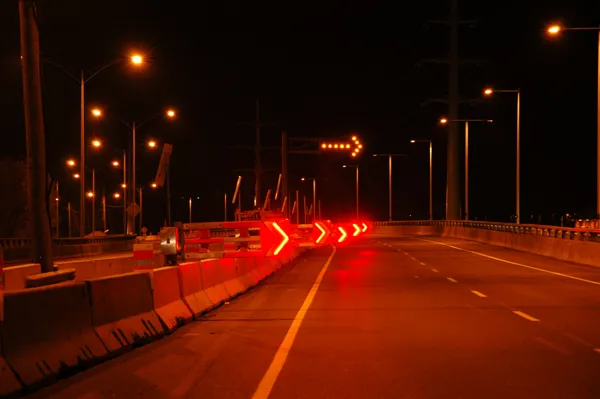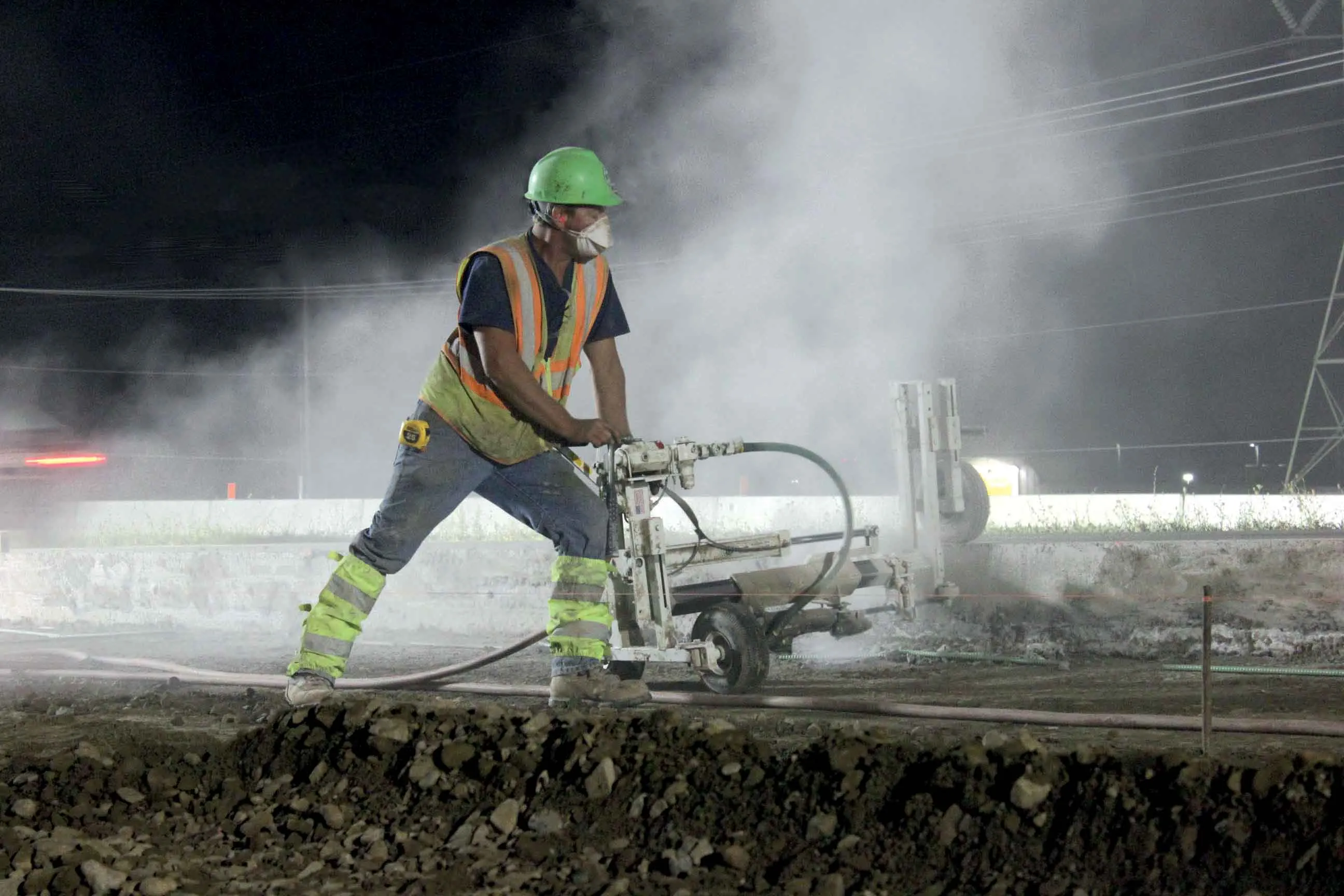Highway construction work zones are dangerous places, and anything that can improve safety is welcomed as Patrick Smith reports. The safe and efficient flow of traffic through work zones is a major concern to transportation officials, industry, the public, businesses, and commercial motor carriers. This is the view of the US Federal Highway Administration (FHWA), which has developed the Highway Work Zone Safety Program to reduce the fatalities and injurious crashes in work zones, and to enhance traffic oper
February 15, 2012
Read time: 7 mins

Highway construction work zones are dangerous places, and anything that can improve safety is welcomed as Patrick Smith reports
The safe and efficient flow of traffic through work zones is a major concern to transportation officials, industry, the public, businesses, and commercial motor carriers. This is the view of the USIts aims are similar to many road authorities worldwide, who are also continually looking at ways to make those employed on highway construction and repairs much safer.
Over the last five years in the USA alone, 4,400 people died in work zone crashes of which 85% were drivers or passengers, and 200,000 people were injured.
Rear-end crashes are the most common type of work zone crashes, and some 42% of work zone crashes occur in the transition zone prior to the work area.
This is why each year in April, National Work Zone Awareness Week is held in the USA to bring national attention to motorist and worker safety and mobility issues in work zones. Starting in 1999, the FHWA has worked with the American Association of State Highway and Transportation Officials (AASHTO) and the
American Road & Transportation Builders Association (ARTBA) chairman Bill Cox, a highway contractor from Maryland and president of Corman Construction, appears in a second public service announcement (PSA).
Both PSAs are aimed at boosting awareness and use of the clearinghouse by highlighting the facility's webinars, laws and regulations, statistics, training, public education and best practice materials that are available at www.workzonesafety.org.
Managed by the ARTBA Transportation Development Foundation (ARTBA-TDF), the clearinghouse is the USA's first and most comprehensive information resource on roadway construction zone safety serving more than 200,000 users annually. Its day-to-day operations are handled by the
During ATSSA's 41st Annual Convention and Traffic Expo held earlier this year in Phoenix, Arizona, a variety of work zone safety equipment was displayed, and the 2011 ATSSA Innovation Award winners received their awards. The three winners were
The RoadQuake is a temporary rumble strip that requires no fasteners or adhesives for installation, which can be carried out by a crew of two in minutes. The all-weather portable traffic device alerts drivers to reduce their speed in highway and road construction zones, and at 3.35m long it can transverse an entire lane.
SwiftGate is claimed to be "a step forward in efficient traffic control and highway worker safety." Versilis was set up by QMB Barrier in order to develop new solutions to maximise road safety while minimising impact on traffic flow, and operating mainly in Quebec and Ontario, Canada, the QMB Barrier service company specialises in road traffic management. Among its products it also markets the Quickchange Moveable Barrier from
The Versilis SwiftGate is a remote-control traffic control system, and the latest version (which has obtained FHWA approval) is currently fully operational in Montreal.
Because lane closures can be hazardous, time-consuming and costly, the SwiftGate lane closure system comprises a series of easily installed solar-powered gate modules made of a pivoting gate or sign, a solar panel and a control box. Gates can vary in length and can be adapted with traffic signs and/or flashing lights. Long distance commands are sent by high-frequency radio signals to activate the gate system.
SwiftGate system has received an approval letter from the FHWA for its compliance with NCHRP 350 (National Cooperative Highway Research Program), declaring it safe for use on the National Highway system.
Its SwiftSign product uses the same technology but as opposed to the SwiftGate, which is used solely for lane closures applications, the SwiftSign can be used independently for a wide variety of applications. The system comprises a pivoting sign, solar panel and control box. Flashing lights can be added to the sign for increased night-time visibility, and it can be activated with an RF (radio frequency) unit, mobile phone or web-based application. The system can be adapted to host any kind of signage or message board as long as it is reasonable in size and complies with local traffic regulations.
"The SwiftSign remote control signage system substantially reduces the exposure of roadway workers to live traffic and at the same time reduces the exposure of motorists to heavy road obstacles such as truck-mounted attenuators (TMAs) or unprotected stationary vehicles," says Versilis.
Made from solid coloured, UV resistant, high- density polyethylene, it is designed to withstand over 9,000kg of static pressure, double the (US) federal single-axle vehicle maximum for a single wheel.
"The combination of Tuff Curb XLP's bright solid coloring and unique glass element technology reflectors supply maximum visibility both day and night. Unlike traditional reflectors that only offer reflection from a straight on light source, XLP's reflectors far surpass the mandated 20° reflectivity required by the ASTM D4280 standard by offering reflection over 45° each direction," says Impact Recovery Systems.
The system is fully compatible with the company's line of posts and panels, and its many innovative features and benefits are said to make it ideal for many applications such as work zones, HOV lanes, city streets, turn restrictions, bridges and tunnels.
Available for both temporary and permanent usage, products are MUTCD [Manual on Uniform Traffic Control Devices]-compliant and NCHRP 350-approved.
Another NCHRP 350-accepted work zone safety product is the SonoBlaster, an impact-activated safety device that warns work crews and errant vehicle drivers simultaneously to help prevent crashes and injuries in work zones.
The SonoBlaster from Transpo Industries mounts on typical work zone barricades, cones, drums, delineators, A-frames and other barriers, and when impacted by an errant vehicle its built-in CO2-powered horn blasts at 125dB to signal workers that their protective zone has been violated, giving them critical reaction time to move out of harm's way.
High visibility and longer distances means more preview time for drivers to see, think and react as they drive through hazardous work zones, says
And as the brightness of pavement markings becomes more critical as drivers age, the company offers its Davidson's RPMs and Halftrack durable work zone markers.
"Night driving is especially dangerous in work zones. RPMs and Halftracks utilise a highly efficient cube-corner microprism reflector which makes them three times brighter than other markers," says the company, which has also launched the new HOT DOT centre-mount reflector, a highly abrasion and impact-resistant roadway reflector for permanent and bright delineation.
"The reflectors, available from Pexco's Davidson Traffic Control Products division, are used in a variety of traffic safety applications that require unsurpassed brightness and long-lasting delineation that can withstand temperatures as low as -20°.
"Unlike traditional moulded acrylic reflectors, HOT DOT units are constructed of a durable extruded polycarbonate that is laminated onto Reflexite brand cube-corner micro-prismatic abrasion-resistant sheeting. This combination of materials ensures the reflectors."
Another recently launched safety product comes from
"The Workzone Backsense is ideal for light to medium duty mobile plant machinery, completing Brigade's portfolio of Xtreme and Standard pulsed radar obstacle-detection systems," says the company.
"Unlike most radar systems Workzone has two antennas offering complementary detection ranges. One antenna offers a shorter radar beam for close-in detection across the back of the vehicle, while the other offers a 3m range and is approximately the width of the vehicle, thus preventing false alarms. The sensors are connected to an in-cab warning device to alert the driver of an object, vehicle or person in his danger zone when manoeuvring."








